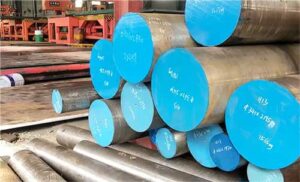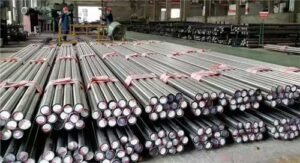In the realm of metallurgy and materials science, the role of steel in various industrial applications is paramount. Among the many specialized types of steel available, hot work tool steel stands out as a material with remarkable properties and versatility. This article will delve deep into the key properties of hot work tool steel, explaining its significance in the manufacturing and engineering sectors.
1. Introduction
Hot work tool steel is a class of steel specifically designed to withstand high-temperature applications. It plays a critical role in various industrial processes, particularly those involving shaping, cutting, and forming materials at elevated temperatures. The unique properties of hot work tool steel make it an indispensable material in industries such as die casting, forging, and extrusion.
2. Composition of Hot Work Tool Steel
Alloying Elements
Hot work tool steel is alloyed with elements like chromium, tungsten, molybdenum, and vanadium. These alloying elements impart specific properties to the steel, such as heat resistance, wear resistance, and toughness.
Carbon Content
The carbon content in hot work tool steel is carefully controlled to optimize hardness and toughness. Higher carbon content can lead to increased hardness but may reduce toughness.
Other Additions
Additional elements like silicon and manganese may be added to improve specific characteristics, such as hardenability and machinability.
3. Heat Resistance
Operating Temperatures
One of the primary properties of hot work tool steel is its exceptional heat resistance. It can maintain its mechanical properties even at temperatures exceeding 600°C (1112°F).
Resistance to Thermal Fatigue
Hot work tool steel exhibits excellent resistance to thermal fatigue, making it ideal for applications involving cyclic heating and cooling.
Retention of Hardness
Even at high operating temperatures, hot work tool steel retains its hardness and dimensional stability, ensuring consistent performance.
4. Wear Resistance
Abrasion Resistance
Hot work tool steel offers outstanding abrasion resistance, making it suitable for applications where materials are subjected to severe wear and friction.
Adhesion Resistance
In applications involving high-temperature contact with other materials, hot work tool steel’s adhesion resistance prevents material buildup.
Erosion Resistance
The steel’s erosion resistance is crucial in environments where high-velocity particles or gases may cause surface degradation.
5. Toughness
Impact Resistance
Despite its hardness, hot work tool steel maintains good impact resistance, reducing the risk of fractures or breakages.
Fracture Toughness
The steel’s fracture toughness ensures that it can withstand sudden, high-stress loads without catastrophic failure.
6. Dimensional Stability
Minimal Distortion
Hot work tool steel exhibits minimal distortion during heat treatment, ensuring precise and consistent part dimensions.
Reduced Deformation
Even under high-temperature conditions, the steel’s reduced deformation minimizes the need for additional machining or correction.
7. Machinability
Ease of Machining
Hot work tool steel is known for its excellent machinability, allowing for efficient production processes.
Tool Life Improvement
When used as cutting or forming tools, hot work tool steel can significantly improve tool life, reducing production costs.
8. Corrosion Resistance
Resistance to Oxidation
Hot work tool steel demonstrates resistance to oxidation, preventing the formation of surface rust or corrosion.
Environmental Factors
Its corrosion resistance can be affected by the surrounding environment, so proper maintenance and protection may be necessary.
9. Applications of Hot Work Tool Steel
Hot work tool steel finds applications in various industrial processes, including:
- Die Casting: It is widely used for making die casting molds due to its high thermal conductivity and wear resistance.
- Forging: Hot work tool steel is essential for forging dies, ensuring the production of high-quality forged components.
- Extrusion: In extrusion processes, hot work tool steel maintains its properties even under extreme pressures and temperatures.
- Other Industrial Uses: Beyond these applications, it is also employed in industries such as automotive, aerospace, and plastic processing.
10. FAQs
Frequently Asked Questions About Hot Work Tool Steel
Q1. What is the difference between hot work tool steel and cold work tool steel?
Hot work tool steel is designed to withstand high-temperature applications, while cold work tool steel is used in applications involving lower temperatures and is primarily concerned with wear resistance.
Q2. Can hot work tool steel be heat-treated for specific properties?
Yes, hot work tool steel can be heat-treated to achieve desired properties such as hardness, toughness, and wear resistance.
Q3. Are there different grades of hot work tool steel?
Yes, there are various grades of hot work tool steel, each tailored for specific applications and operating conditions.
Q4. What precautions should be taken when working with hot work tool steel?
Safety precautions include proper ventilation during machining, wearing appropriate protective gear, and ensuring safe storage to prevent accidents.
Q5. Is hot work tool steel suitable for use in the aerospace industry?
Yes, hot work tool steel is used in the aerospace industry for applications that require high-temperature resistance and precision.
In conclusion, hot work tool steel is a remarkable material with a unique combination of properties that make it indispensable in a wide range of industrial applications. Its ability to withstand high temperatures, resist wear and corrosion, maintain toughness, and exhibit excellent machinability makes it a key player in industries that demand performance and reliability in extreme conditions. Understanding the properties and applications of hot work tool steel is essential for engineers and manufacturers seeking to optimize their processes and deliver high-quality products.

